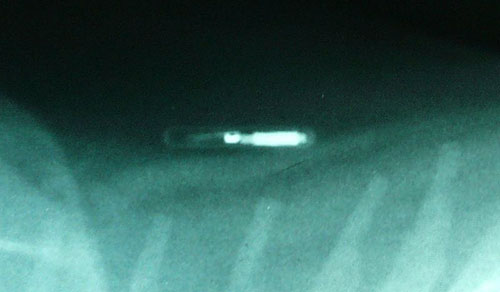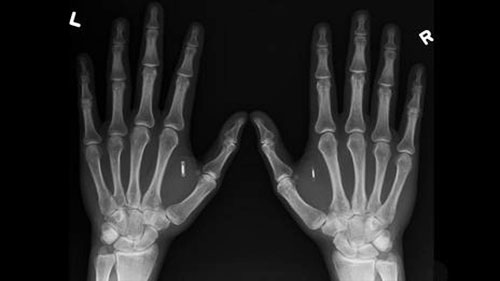|
from TheTruthWins Website
Would you like to have an RFID microchip implanted under your skin?
If you are anything like me, you would never allow such a thing to be done. But many others, especially among the younger generations, see things very differently.
RFID microchip implants and other forms of "wearable technology" are increasingly being viewed as "cool", "trendy" and "cutting edge" by young people that wish to "enhance" themselves. And of course the mainstream media is all in favor of these "technological advancements".
For example, the BBC just published a piece entitled "Why I Want A Microchip Implant".
We are told that such implants could solve a whole host of societal problems. Identity theft and credit card fraud would be nearly eliminated, many other forms of crime would be significantly reduced, children would never go missing and we wouldn't have to remember a vast array of passwords and PIN numbers like we do now.
We are told that if we just adopted such technology that our lives would be so much better.
But is that really the case?
As our society becomes "digitally integrated", technologists tell us that it is "inevitable" that wearable technology will become as common as smart phones are today.
And the BBC article that I just mentioned is very eager for that day to arrive…
And for some people, that day is already here.
In fact, at some technology conferences people actually line up to get chipped…
How creepy is that?
In addition, scientists have now developed batteries that are powered by the human body that could be used to provide a permanent power source for implantable technology.
The following is a brief excerpt from a recent article by Kristan Harris entitled "Scientists Develop Human-Powered Battery For RFID Implantable Chips"…
Of course RFID microchips don't actually have to be implanted to be useful.
In fact, they are already being used to track schoolchildren all over the United States…
And over in the UK, RFID microchips are being used to track children wherever they go all day long…
We are rapidly entering a dystopian future in which it will be "normal" for technology to monitor our movements 24 hours a day.
Most people will probably welcome this change, but it also opens up the door for an oppressive government to someday greatly abuse this technology.
Another type of "wearable technology" that is rapidly gaining acceptance is "smart tattoos". Normally, we are accustomed to thinking of tattoos as body art. But that is about to change.
Just check out this excerpt from a recent Gizmodo article…
In fact, a company called MC10 is working on a wide range of "smart tattoos" that will be able to do some pretty wild things…
And Motorola actually has a patent for a tattoo that will take commands from unvocalized words in your throat…
They are calling it "wearable computing", and what we are witnessing now is just the tip of the iceberg. What we will see in the future is probably far beyond anything that any of us could imagine right now.
The following is from a recent Computer World article…
All of this may sound very "cool" to a lot of people.
But,
I think that you can see where I am going with this.
Technology is truly a double-edged sword. It can do great good, but it can also be used for great evil.
10 February 2014
by a company called VeriChip, stores personal medical information.
(Rhona Wise/AFP/Getty)
you can do everything from unlocking doors to starting motorbikes, says Frank Swain,
who has been trying to get his
own implant.
A few years ago, I perched on the edge of my bed in a tiny flat, breathing in a cloud of acetone fumes, using a scalpel to pick at the corner of an electronic travel card.
More than 10 million Londoners use these Oyster cards to ride the city's public transport network. I had decided to dissect mine. After letting the card sit in pink nail polish remover for a week, the plastic had softened enough that I could peel apart the layers.
Buried inside was a tiny microchip attached to a fine copper wire: the radio frequency identification (RFID) chip.
My goal was to bury the chip under my skin, so that the machine barriers at the entrance to the Underground would fly open with a wave of my hand, as if I was some kind of technological wizard.
But although I had the chip and an ex-Royal Marines medic willing to do the surgery, I failed to get my hands on the high-grade silicone I'd need to coat the chip to prevent my body reacting against it.
Since then, people have used the technique I helped popularize (below video) to put liberated Oyster chips in bracelets, rings, magic wands, even fruit, but the prize for first London transport cyborg is still up for grabs.
The person who does will find themselves inducted into the community of "grinders" - hobbyists who modify their own body with technological improvements. Just as you might find petrol heads poring over an engine, or hackers tinkering away at software code, grinders dream up ways to tweak their own bodies.
One of the most popular upgrades is to implant a microchip under the skin, usually in the soft webbing between the thumb and forefinger.
Many people now have chips implanted in the fleshy part between thumb and index finger. (Amal Graafstra/Dangerous Things)
Take Amal Graafstra, a self-described "adventure technologist" and founder of biohacking company Dangerous Things in Seattle, Washington. He is a double implantee - he has a microchip in each hand.
In his right hand is a re-writable chip, the same kind used in Oyster travel cards, which can be used to store small amounts of data. By pressing his hand to his phone, information can be downloaded from his body or uploaded into it.
The left contains a simple identity number that can be scanned to unlock his front door, log into his computer or even start a motorbike (see video, below).
This month at the Transhuman Visions conference in San Francisco, Graafstra set up an "implantation station" offering attendees the chance to be chipped at $50 a time.
Using a large needle designed for microchipping pets, Graafstra injected a glass-coated RFID tag the size of a rice grain into each volunteer. By the end of the day Graafstra had created 15 new cyborgs.
For other people, though, the idea of implanting themselves with microchips may conjure up spectres of surveillance and totalitarian control.
Yet if that's true, what's the point of implanting it?
Graafstra and his fellow cyborgs could just as easily use a chip inside plastic wallet to store data, and a key to open his front door or start a motorbike.
Still, there are some advantages: one benefit is that you'll never lose the chip, and it makes physical theft impossible - at least unless a thief is prepared for some gruesome surgery.
Graafsta also points out that embedding the chip under the skin reduces the distance that it can be read with a scanner, making it more secure. When it's in your arm or hand, there's less chance someone can surreptitiously scan your details, by sweeping a card reader nearby.
Sub-skin capsule with chip that can be read by scanners (Amal Graafstra/Dangerous Things)
Ultimately, implanted microchips offer a way to make your physical body machine-readable.
Currently, there is no single standard of communicating with the machines that underpin society - from building access panels to ATMs - but an endless diversity of identification systems:
All of these are attempts to bridge the divide between your digital and physical identity, and if you forget or lose them, you are suddenly cut off from your bank account, your gym, your ride home, your proof of ID, and more.
An implanted chip, by contrast, could act as our universal identity token for navigating the machine-regulated world.
Yet to work, such a chip would need to be truly universal and account for potential obsolescence. My own flirtation with implanted technology came to an end when I moved away from London, making an Oyster-equipped hand pointless.
Even with a return to London on the cards, I'm thinking twice about returning to my project, since Oyster cards are being phased out.
Such a development may actually be a cause for optimism for implant enthusiasts, however, because instead of Oyster cards, London's transport authority is allowing people to ride the subways and buses using bank cards.
It marks the beginnings of a slow move toward a world where everything will be accessed from a single RFID microchip. If that day comes, I can't think of a safer place to keep it than inside my own body.
|




